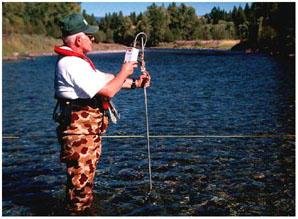Technical Support for DFLOW
On this page:
-

- What should I do if I receive the error message "The paging file is too small for this operation to complete"?
- Where do I obtain flow data?
- In what format should the input flow data be?
- What is meant by "Common dates" and "Longest period" in the "Calculation Period" box?
- Can DFLOW be used to calculate seasonal design flows?
- What references does EPA have on design flows?
- USGS SWToolbox Dflow contact and software information.
- Who should I contact at EPA if I have additional DFLOW questions?
Why does DFLOW 3.1 sometimes give different values for an xQy flow than the USGS’s program SWSTAT?
There may small differences between DFLOW and USGS results due to rounding or other slight differences in the algorithms for the Log-Pearson III technique. These differences are usually less than 1% but can be as much as 4%. If decisions based on DFLOW calculations are sensitive to a small change in flow, then the USGS SWSTAT program should be used to calculate flows.
Significant differences will likely occur when the n-day average (e.g., 7-day average for a 7Q10 statistic) for a given year is zero or there are days with missing data in any particular year. In both of these cases, the USGS program SWSTAT does not use the data for the entire year although DFLOW does. EPA is working to fix this problem and will provide additional information on this website when it is available. When there are differences between the two values, the USGS value should be used.
What should I do if I receive the error message "The paging file is too small for this operation to complete"?
The paging file is a hidden file on the hard disk that Windows uses to hold parts of programs and data files that do not fit in memory. If you receive this message, you need to increase the size of your paging file. The steps to change the size of the paging file vary by operating system, but should be outlined in the Windows help file. For Windows 2000, go to Control Panel, Systems, and then select the Advanced tab. Click "Performance Options" and then "Change." Increase the number of the initial size and maximum size of your paging file.
Where do I obtain flow data?
Flow data can be obtained from stream data repositories such as USGS Daily Streamflow for the Nation
In what format should the input flow data be?
The DFLOW 3.1 zip file contains several sample flow data files. The flow data should be in a text file (.txt). As the files illustrate, initial comment lines in a flowdata.txt file should be denoted with the "#" symbol. The data should be listed in row and column format, where the four columns are: Agency Code, station number, Date of daily mean streamflow, and Daily mean streamflow value.
What is meant by "Common dates" and "Longest period" in the "Calculation Period" box?
Although a flow record may be for a long period of time (e.g., 1900-present), there may be no data for some dates. When DFLOW is calculating design flow statistics for multiple stations and "Common dates," is selected, only flow measurements from days in which all stations have recorded data will be used in the calculations. This could be important to insure consistency of results between stations. The "Longest period" specification directs DFLOW to only use data from the longest period of consecutive daily measurements within a flow record.
Can DFLOW be used to calculate seasonal design flows?
Yes. In the "Season" box, specify the first and last day of the Julian day of the season, where in this context the Julian day is the number of days that have elapsed in the particular calendar year (e.g., January 1 = 1, February 28 = 59).
What references does EPA have on design flows?
In addition to the DFLOW 3.1 User's Guide and EPA's Technical Guidance Manual for Performing Wasteload Allocation. Book IV: Design Conditions, Chapter 1 (PDF) (65pp, 310k), another useful reference is: EPA. 1991. Technical Support Document for Water Quality-based Toxics Control. EPA/505/2-90-001.
USGS SWToolbox Dflow contact and software information.
USGS manages DFlow as a rebranded product called SWToolbox
(https://www.usgs.gov/software/swtoolbox-software-information).
Questions can be sent to SWToolboxTesting ([email protected]).
Who should I contact at EPA if I have additional DFLOW questions?
E-mail [email protected] (Hydrologic Toolbox Help) with additional comments or questions on DFLOW.
